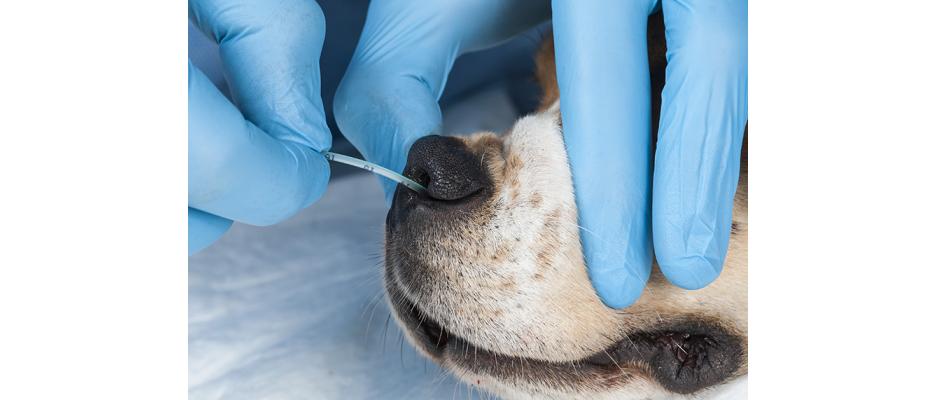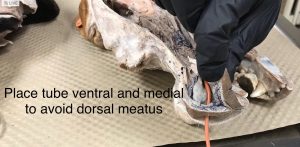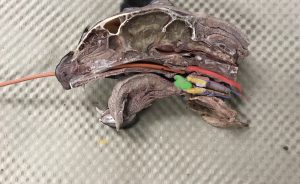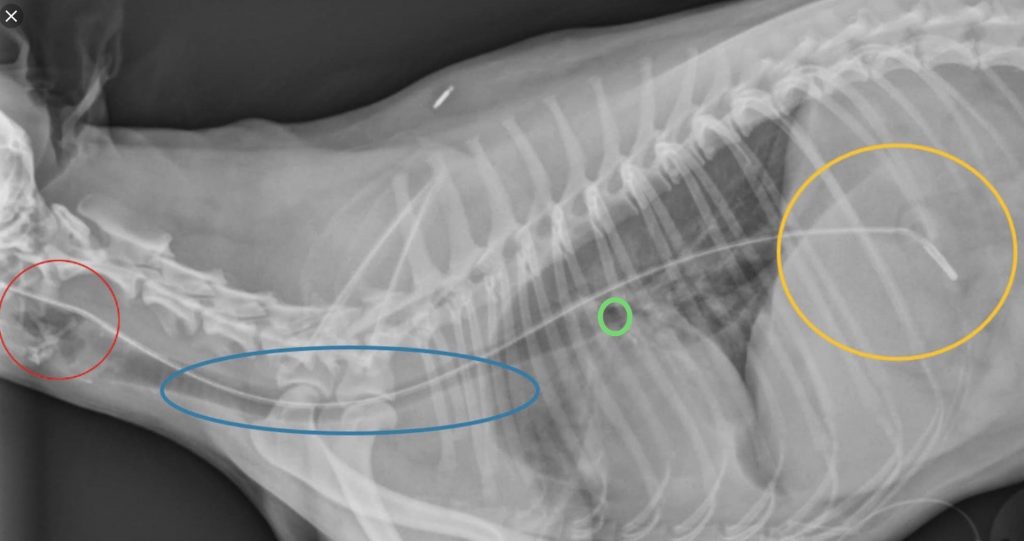22 SA NG Tube Placement
NG TUBE PLACEMENT
Small Animal-NG tubes often placed in quiet and compliant awake patients, or patients under light sedation.
Large Animal-NG tubes often placed in awake compliant patients-common in horses. You will learn this technique in LAM and LAS.
-
-
- Apply lidocaine into nostril (some use ophthalmic Proparacaine and place an additional couple drops into eye of same side as nostril being used-cool trick to anesthetize nasal passage) Wait 2 minutes!
- Pick appropriate length and width of tube for size of patient and measure tube to last rib for NG tube to 7-8 rib for NE tube and mark tube with Sharpe (generally not helpful to use tape to mark as impedes gentle movement through sensitive nasal mucosa). Most tubes made especially for feeding cats and dogs, give size guidelines and have weighted tips to ease placement and are radio dense to show up well on radiographs, some can be trimmed, others are one length only. Most cats 5 fr red rubber catheter works well.
- Lube tube
- Have holder slightly stretch out the head and neck of patient
- Gently push nasal planum dorsal (some times called “piggy nose”)

- Aim the tube ventral and medial to avoid the dorsal meatus and into nasopharynx-oropharynx,

- Gently advance tube, (some will sneeze) when close to epiglottis (by eyeballing how much tube is in), have the restrainer direct the nose downward to help direct tube into esophagus. Please note the following structures in the photo of an anatomical specimen of half a cat head and neck below; Yellow-Larynx, Blue-Trachea, Red-Esophagus. The NG tube is right at the epiglottis-this is the point at which the tube could go over the dorsal aspect of the closed epiglottis and into the esophagus (proper placement), or accidentally be directed between the laryngeal folds into the trachea (improper placement). By gently placing nose down as you are feeding the tube, the tube is directed dorsally over the epiglottis and into the esophagus. THIS IS AN IMPORTANT POINT!

Red rubber catheter at the point of either going dorsal over the green epiglottis, or more ventral within the yellow larynx and between the aretenoid cartilages and vocal folds into the trachea! Esophagus outlined in red, trachea outlined in blue - Watch for swallow, this takes some practice as can be subtle. Remember the swallow reflect will be subdued in a sedated or moribund patient, and absent in an anesthetized patient-who should have ET tube placed, and of course you wont see this reflex in a cadaver).
- Continue to pass tube until you see the mark at the nose-you may of may not see the tube pass along the left side of the neck (tube is pretty small)
- CONFIRM TUBE PLACEMENT
- drawing back with syringe on tube (negative pressure),
- instill a few mls of air and auscultate for bubbling sound on left cranial abdomen-the location of the stomach
- if you retrieve fluid low pH is indicative of stomach contents vs fluid closer to pH of 7 from resp tract.
- Remember no cough is not a reliable indicator of being in the esophagus/stomach especially if the patient is sedated!
- Also palpate neck you should feel trachea and maybe additionally feel the NG tube (difficult if very small tube),
- Depending on how sedate an animal is you can confirm placement by direct visualization!
- Ideally take radiograph-either V/D or Lateral (required by U of MN VMC in SA patients with NG tube). SEE RADIOGRAPH BELOW
- dorsal to larynx, variable position by thoracic inlet as esophagus overlaps trachea, dorsal to Corina, past diaphragm in stomach
- In larger animals you can sometimes see or palpate the NG tube as it passes into the esophagus as in horses on the left side of the neck.
- Secure by suturing to side of nasal planum/skin juncture and side of face or to dorsal muzzle to the stop area, between the eyes to the top of head. AVOID THE WHISKERS they are very sensitive. Securing is a variable art be open to how SAM/ICU/ECC secures NG tubes as they have a lot of experience! Finger trap suture, several single sutures, sutures through tape attached to tube are all viable options.


- An E-collar is usually placed to prevent rubbing on tube.
- Steps to use tubes for feeding will be covered in Nutrition/SAM and other rotations-very important that owners fully understand and demonstrate their hands on knowledge of tubes before going home with patient!
- If any question regarding proper tube placement by owners-have patient come to clinic for quick recheck by CVT, don’t have owners replace tube at home!
- Removal-some place a drop of Ophthaine in nostril, cut suture, kink tube closed and pull gently and fairly swiftly out, patients often crinkle up nose and may sneeze or cough, and occasionally can have a few drops of blood from irritated nasal mucosa.
- We’ll go over proper NG tube placement using radiographs in lab. University of Minnesota, VMC requires the radiographic confirmation of NG tube placement for SA patients. Think about what the significance of these 4 anatomical landmarks are in regards to NG tube placement?
-

- NG TUBE IN A NUTSHELL-used to put things in meds/food, take things out air/fluid/ingesta to improve stomach function prevent reflux etc…
- Place a couple drops of Ophthalmic Proparacaine in nasal passage and place an additional couple drops into the eye of the same side for additional nasopharyngeal local anesthesia. (often clinics will keep a separate bottle of ophthalmic proparicaine just for this purpose)
- Pick appropriate length and width of tube for size of patient
- Measure NG tube to last rib, NE tube to 7-8 th rib & mark w/Sharpie
- Lube tube
- Have holder slightly stretch out the head and neck of patient
- Gently push nasal planum dorsal (sometimes called “piggy nose”)
- Aim the tube ventral and medial to avoid the dorsal meatus and into nasopharynx-oropharynx,
- Gently advance the tube- some will sneeze. When close to epiglottis (by eyeballing how much tube is in), have the restrainer direct the nose downward to help direct the tube into the esophagus.
- Watch for swallowing, in awake patients.
- Continue to pass tube until you see the mark at the nose-you may of may not see the tube pass along the left side of the neck (tube is pretty small)
- CONFIRM TUBE PLACEMENT(Different indicators of tube placement)
- Drawing back with syringe on tube (negative pressure),
- Instill a few mls of air and auscultate for bubbling sound on left cranial abdomen-the location of the stomach.
- If patient is sedated no coughing is not a reliable indicator of appropriate placement
- Palpate neck for NG tube is generally not helpful as NG tube is so small its is difficult to feel.
- Depending on how sedate an animal is you can confirm placement by direct visualization!
- If you retrieve fluid low pH is indicative of stomach contents vs fluid closer to pH of 7 from the respiratory tract.
- Ideally take radiograph-either V/D or Lateral (required by U of MN VMC in SA patients with NG tube).
- dorsal to larynx, variable position by thoracic inlet as esophagus overlaps trachea, dorsal to Corina, past diaphragm in stomach
- Secure by suturing to a location that is preferred by the clinician. AVOID THE WHISKERS as they are very sensitive. Finger trap suture, several single sutures, sutures through tape attached to tube are all viable options.
- An E-collar is usually placed to prevent rubbing on the tube.
- Removal-some place a drop of Ophthaine in nostril prior to removal to ease removal
- cut suture, kink tube closed and pull gently and fairly swiftly out, patients often crinkle up nose and may sneeze or cough, and occasionally can have a few drops of blood from irritated nasal mucosa.
